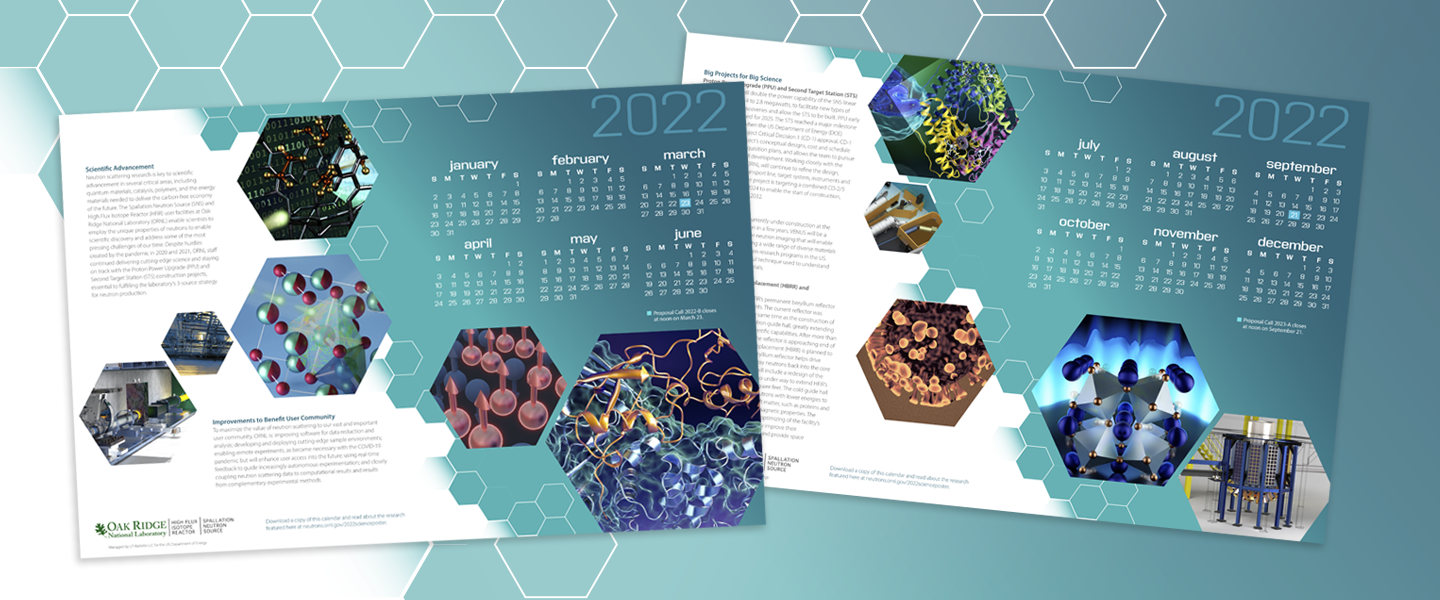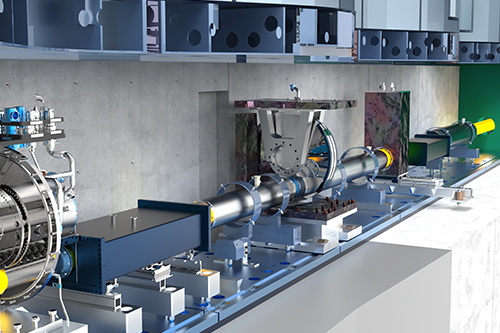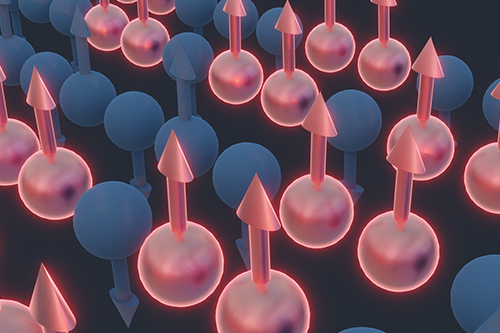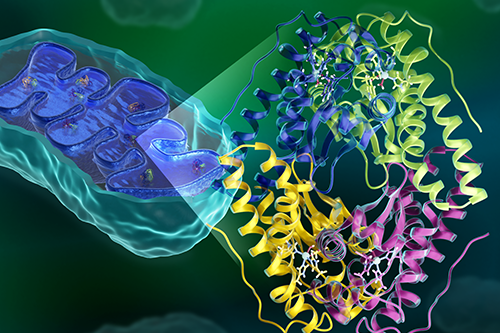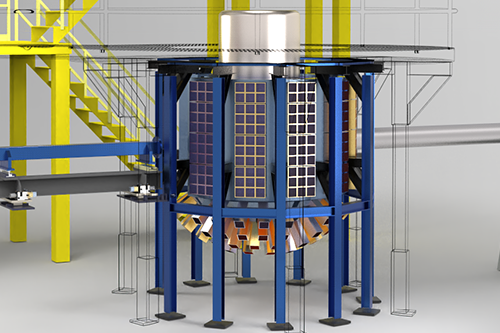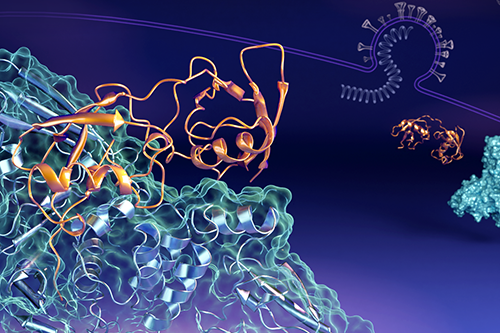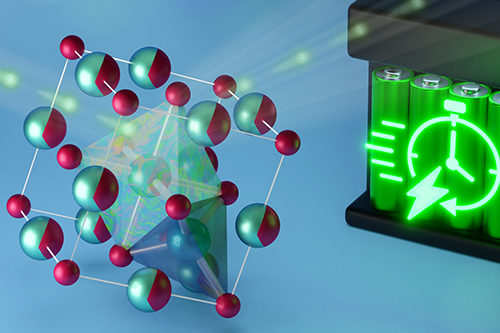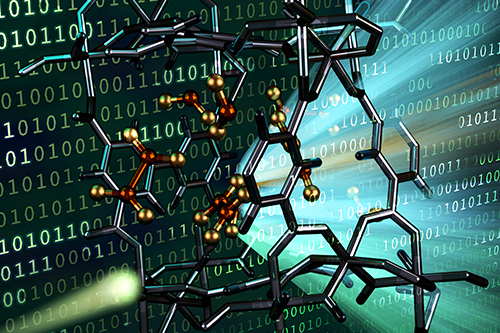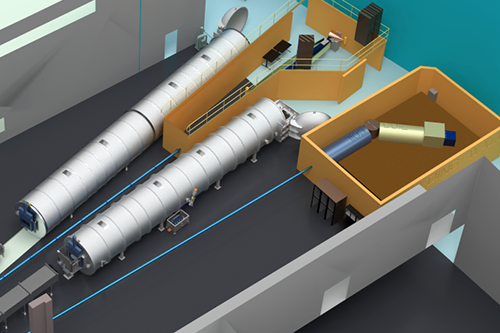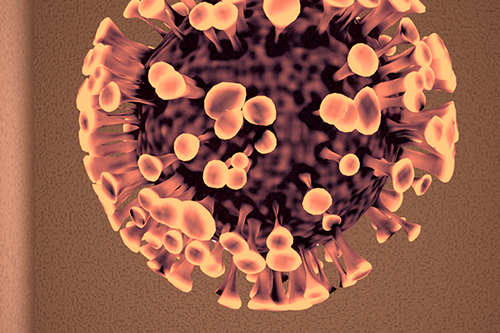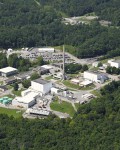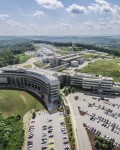SNS and HFIR 2022 Calendar Poster
The 2022 Neutron Sciences calendar poster spotlights some of the impactful research and operational achievements made over the past year at the Spallation Neutron Source (SNS) and the High Flux Isotope Reactor (HFIR). Despite ongoing challenges associated with COVID-19, NScD staff were undeterred in delivering cutting-edge science and taking significant strides with major facility upgrades, including the Proton Power Upgrade (PPU) and the Second Target Station (STS) projects.
Venus neutron imaging beamline is taking shape
Under construction at the SNS facility, the VENUS beamline will provide the US with unique neutron scattering capabilities for studying a wide range of materials used in building technologies, transportation industries, additive manufacturing, nuclear fuels, biological systems, geosciences, and more.
Under construction at the SNS facility, the VENUS beamline will provide the US with unique neutron scattering capabilities for studying a wide range of materials used in building technologies, transportation industries, additive manufacturing, nuclear fuels, biological systems, geosciences, and more.
Quantum material’s subtle spin behavior proves theoretical predictions
Scientists found, for the first time in quantum materials, evidence of hard-to-observe dynamics called Kardar-Parisi-Zhang. Better understanding how the magnetic particles in the system behave could lead to advanced applications in heat transport and novel spintronic devices with improved energy efficiency and performance.
Scientists found, for the first time in quantum materials, evidence of hard-to-observe dynamics called Kardar-Parisi-Zhang. Better understanding how the magnetic particles in the system behave could lead to advanced applications in heat transport and novel spintronic devices with improved energy efficiency and performance.
Revealing the inner workings of antioxidant enzymes with therapeutic potential
Researchers from the University of Nebraska Medical Center have a better understanding of how the enzyme manganese superoxide dismutase (MnSOD) plays a critical role in maintaining human health by keeping the number of harmful reactive oxygen molecules in cells under control. Neutron insights into its catalytic mechanism could spur novel MnSOD-based therapeutics and provide new possibilities for studying similar enzymes that perform important functions in human cells.
Researchers from the University of Nebraska Medical Center have a better understanding of how the enzyme manganese superoxide dismutase (MnSOD) plays a critical role in maintaining human health by keeping the number of harmful reactive oxygen molecules in cells under control. Neutron insights into its catalytic mechanism could spur novel MnSOD-based therapeutics and provide new possibilities for studying similar enzymes that perform important functions in human cells.
First 8 instruments selected for the Second Target Station
The STS project achieved a key milestone in July with selection of the eight world-class instruments to be built during the construction phase. The chosen instruments will provide transformational new capabilities to advance materials research that supports the US economy with information that cannot be obtained using any other research method.
The STS project achieved a key milestone in July with selection of the eight world-class instruments to be built during the construction phase. The chosen instruments will provide transformational new capabilities to advance materials research that supports the US economy with information that cannot be obtained using any other research method.
First ‘BIM’ then Bam! PPU’s first step is a success
In May, teams installed 1.3 miles of stainless-steel piping for the PPU cooling system thanks in part to the use of building information modeling, or “BIM.” The aim of the PPU is to double the power of the SNS accelerator from 1.4 to 2.8 megawatts. BIM procedures permit virtually building a facility prior to its actual physical construction, which reduces uncertainty, improves safety, helps work out problems, and simulates and analyzes potential impacts.
In May, teams installed 1.3 miles of stainless-steel piping for the PPU cooling system thanks in part to the use of building information modeling, or “BIM.” The aim of the PPU is to double the power of the SNS accelerator from 1.4 to 2.8 megawatts. BIM procedures permit virtually building a facility prior to its actual physical construction, which reduces uncertainty, improves safety, helps work out problems, and simulates and analyzes potential impacts.
Neutrons catch shape-shifting coronavirus protein complex in the act
ORNL researchers used neutrons to reveal the molecular details of how a key protein (the papain-like protease, or “PLpro”) from SARS-CoV-2—the virus that causes COVID-19—links up to form a paired-structure, or “complex,” with a human protein named interferon-stimulated gene 15 (ISG15). PLpro strips ISG15 from other human cellular proteins to aid SARS-CoV-2 in evading the immune response. Understanding how the two proteins interact could aid in developing therapeutic drug treatments that prevent its formation and allow a person’s immune system to better fight the invading virus.
ORNL researchers used neutrons to reveal the molecular details of how a key protein (the papain-like protease, or “PLpro”) from SARS-CoV-2—the virus that causes COVID-19—links up to form a paired-structure, or “complex,” with a human protein named interferon-stimulated gene 15 (ISG15). PLpro strips ISG15 from other human cellular proteins to aid SARS-CoV-2 in evading the immune response. Understanding how the two proteins interact could aid in developing therapeutic drug treatments that prevent its formation and allow a person’s immune system to better fight the invading virus.
A cousin of table salt could make energy storage faster and safer
UC San Diego scientists used neutron scattering at ORNL to study a material that could be used to make safer, faster-charging batteries. The researchers produced samples of lithium vanadium oxide (Li3V2O5), a “disordered rock salt” similar to table salt but with a certain degree of randomness in the arrangement of its atoms. The samples were placed in a powerful neutron beam that enabled observing the activity of ions inside the material after a voltage was applied.
UC San Diego scientists used neutron scattering at ORNL to study a material that could be used to make safer, faster-charging batteries. The researchers produced samples of lithium vanadium oxide (Li3V2O5), a “disordered rock salt” similar to table salt but with a certain degree of randomness in the arrangement of its atoms. The samples were placed in a powerful neutron beam that enabled observing the activity of ions inside the material after a voltage was applied.
Ramping up data reduction and analysis
Neutron Sciences has made significant improvements to data reduction software available to users. Four software suites were designed to support specific neutron scattering techniques including powder diffraction, single crystal diffraction, direct geometry spectroscopy, and engineering diffraction. And, to keep up with evolving software and instrument developments, a data reduction tracking tool was created to monitor and provide accurate statistical information on the status of data reduction which, in turn, will allow for more emphasis to be placed on data analysis, analytics, modeling and simulation for improved experiments.
Neutron Sciences has made significant improvements to data reduction software available to users. Four software suites were designed to support specific neutron scattering techniques including powder diffraction, single crystal diffraction, direct geometry spectroscopy, and engineering diffraction. And, to keep up with evolving software and instrument developments, a data reduction tracking tool was created to monitor and provide accurate statistical information on the status of data reduction which, in turn, will allow for more emphasis to be placed on data analysis, analytics, modeling and simulation for improved experiments.
HFIR upgrades: expanding the cold guide hall and replacing the beryllium reflector
Plans are underway to extend HFIR’s cold guide hall by more than 4,000 square feet to allow for reconfiguring and optimizing the cold guide instruments as well as the addition of new instruments. ORNL is also preparing to replace HFIR’s permanent beryllium reflector and other key reactor core components to sustain and enhance HFIR’s operational performance.
Plans are underway to extend HFIR’s cold guide hall by more than 4,000 square feet to allow for reconfiguring and optimizing the cold guide instruments as well as the addition of new instruments. ORNL is also preparing to replace HFIR’s permanent beryllium reflector and other key reactor core components to sustain and enhance HFIR’s operational performance.
Ongoing COVID-19 investigations
Neutron scattering researchers continued their fundamental investigations into the structure and dynamics of SARS-CoV-2, the virus that causes COVID-19. The critical information obtained at ORNL’s SNS and HFIR is helping researchers and pharmaceutical manufacturers around the world develop novel approaches and therapeutics to stop the pandemic.
Neutron scattering researchers continued their fundamental investigations into the structure and dynamics of SARS-CoV-2, the virus that causes COVID-19. The critical information obtained at ORNL’s SNS and HFIR is helping researchers and pharmaceutical manufacturers around the world develop novel approaches and therapeutics to stop the pandemic.
‘Hinged’ atomic structures open the door to next-gen solar power materials
Neutrons at ORNL were used to make the most direct observations to date of the atomic motions inside cesium-lead-bromide crystals. In recent years, the material has shown excellent stability and electron transport capabilities, and a better understanding of its dynamics could help scientists optimize the properties in a wide range of similar materials, some of which have demonstrated more than a 25-percent power conversion efficiency, rivaling that of silicon-based materials used in solar power applications.
Neutrons at ORNL were used to make the most direct observations to date of the atomic motions inside cesium-lead-bromide crystals. In recent years, the material has shown excellent stability and electron transport capabilities, and a better understanding of its dynamics could help scientists optimize the properties in a wide range of similar materials, some of which have demonstrated more than a 25-percent power conversion efficiency, rivaling that of silicon-based materials used in solar power applications.


